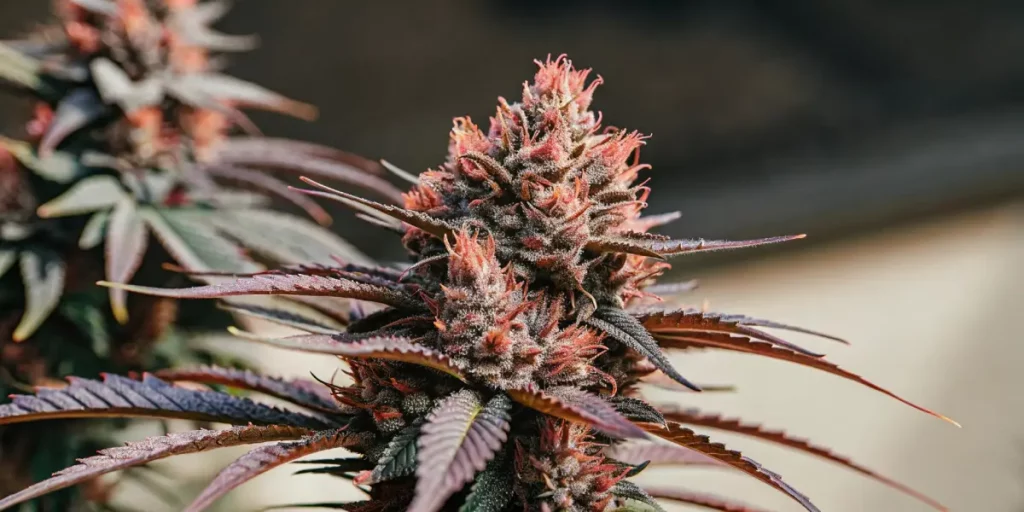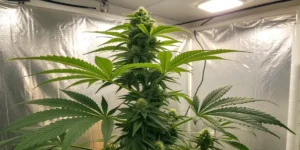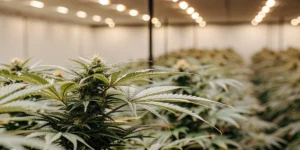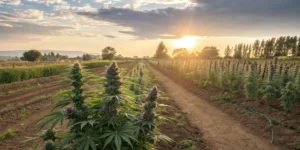Pink Gorilla is an exciting and unique cannabis strain known for its vibrant hues and potent effects. Cultivating this strain requires attention to detail, starting from seed selection. It’s imperative to source your seeds from a reputable supplier to ensure genetic authenticity. Once your seeds are secured, germinate them using the paper towel method. Place seeds between moist paper towels and store them in a warm area, checking daily until you see a taproot.
After germination, transplant the seedlings into small pots filled with a well-draining growing medium like a mix of coco coir and perlite or high-quality potting soil. Ensure your growing medium is pH-balanced, ideally between 6.0 to 6.5. Place the pots in a grow tent or area with sufficient light, utilizing either LED grow lights or appropriate fluorescent bulb options. Maintain a temperature range of 70 to 85 degrees Fahrenheit and a humidity level of 60-70% during the vegetative stage.
As the plants enter the vegetative phase, focus on providing balanced nutritional support. Utilize a nitrogen-rich fertilizer to promote healthy growth, and water your plants carefully, ensuring the top inch of the soil is dry before re-watering. During this stage, regularly check for pests and diseases; early identification and treatment can prevent significant crop damage. Training your plants through methods like topping and low-stress training (LST) can encourage bushier growth and potentially higher yields.
Transitioning into the flowering stage involves reducing light exposure to a 12/12 cycle. This variety typically flowers within 8 to 10 weeks. During this period, switch to a phosphorus and potassium-focused fertilizer to enhance bud development. Pay careful attention to temperature and humidity, reducing humidity levels to 40-50% to prevent mold. Continue training as needed, ensuring adequate light reaches all developing flowers.
As harvest approaches, monitor trichome development to assess maturity. Milky white trichomes with some amber signifies peak potency. Begin cutting back on nutrients two weeks before harvest, known as “flushing,” to improve the final flavor. Once ready, harvest your plants by cutting them at the base, and hang them upside down in a dark, well-ventilated area to dry. This drying process typically lasts 7 to 14 days, after which you can trim and cure the buds for optimal flavor and potency before enjoying your homegrown harvest.
Strain Overview: Traits, Effects & Genetics
Pink Gorilla is a remarkable cannabis strain that has garnered attention among connoisseurs and growers for its unique combination of traits. As a hybrid strain, it typically showcases a balanced blend of both Sativa and Indica genetics, offering consumers the best of both worlds. Visually, this strain is captivating with its vibrant green buds that are often tinged with hues of pink and purple, and covered in a dense layer of crystalline trichomes. The buds are often dense and sticky, indicative of their robust cannabinoid profile, making them a favorite for both smokers and cannabis extractors.
When it comes to effects, this variety is known for inducing a profound sense of relaxation without rendering users completely sedated. The initial cerebral uplift is often accompanied by a euphoric rush, stimulating creativity and social interaction. As the high progresses, the relaxing body effects become more pronounced, making it an excellent choice for easing stress and tension. Despite its calming properties, it doesn’t overwhelmingly couch-lock its consumers, allowing them to remain functional while enjoying its soothing characteristics. Medical users have also praised this cultivar for its potential in alleviating symptoms of anxiety, depression, and chronic pain.
In terms of genetics, this strain often results from a cross between two well-regarded parent strains – the flavorful Gorilla Glue #4 and the exotic Pink 2.0. This lineage bestows the plant with its distinctive aromatic profile, which elegantly combines earthy, sweet, and floral notes, sometimes with a hint of diesel. It inherits high resin production from Gorilla Glue #4, making it a popular choice for concentrate production. With its solid genetic background, this hybrid typically thrives in both indoor and outdoor growing environments, requiring attention to detail in climate control, especially during its flowering stage, to maximize its colorful hues and potent yield.
Optimal Environment to Grow Pink Gorilla Successfully
Pink Gorilla is a unique and vibrant cannabis strain known for its distinctive coloration and potent effects. To grow this strain successfully, providing the optimal environment is essential. This strain thrives in controlled settings where temperature, humidity, and lighting are carefully managed. The ideal temperature range is between 20–25 °C (68–77 °F). Too much heat can stress the plants, whereas too little could hinder their growth. Consider using a digital thermometer to monitor the temperature consistently, ensuring an optimal growing environment.
Humidity plays a crucial role in cultivation. During the vegetative stage, maintain a humidity level of around 60–70% to encourage healthy growth and development. However, as the plants transition to the flowering stage, it is essential to gradually decrease the humidity to around 40–50%. This reduction helps prevent mold and bud rot, which can devastate the crop. Using a hygrometer can assist in maintaining these levels, while a dehumidifier might be necessary in more humid climates.
Proper lighting is vital for optimal growth. This variety requires about 18 hours of light during the vegetative stage, tapering down to 12 hours as it enters the flowering stage. High-intensity discharge (HID) lights, LED, or full-spectrum grow lights are recommended for providing the best light spectrum. Ensure that the light source is neither too close nor too far from the plants to avoid light burn or insufficient light exposure.
Besides temperature, humidity, and lighting, consider the soil conditions. This hybrid benefits from well-aerated soil rich in organic matter. A balanced pH level of around 6.0 to 6.8 is ideal for nutrient uptake. Implementing a regular feeding schedule with high-quality nutrients can further support plant health and maximize yield. Regularly monitoring these environmental parameters will lead to a successful grow, resulting in vibrant, resin-rich buds.
Grow Room Setup for Pink Gorilla Plants
Setting up an ideal grow room for Pink Gorilla cannabis plants is critical to ensuring healthy growth and maximizing yield. This cannabis strain is known for its robust nature and distinctive pink hues, which require specific environmental conditions to thrive. First, consider the space available for your grow room. It should be large enough to accommodate the plants when fully grown and allow room for proper airflow. A grow tent can be a suitable option for those with limited space, helping to control the environment effectively.
Lighting plays a crucial role in the grow room setup. Like most cannabis strains, this variety flourishes under full-spectrum LED grow lights, which imitate natural sunlight and promote healthy photosynthesis. Position the lights approximately 18–24 inches above the canopy during the vegetative stage, and reduce the distance slightly during the flowering stage to enhance bud production. Using a timer for lights ensures your plants receive consistent light cycles, maintaining 18-24 hours of light during vegetation and 12 hours during flowering.
Temperature and humidity are other vital factors in cultivating this strain successfully. The grow room should maintain temperatures between 70-80°F (21-27°C) during the day and slightly cooler at night. Humidity levels should be around 40-60% during vegetation and reduced to 30-40% during flowering to prevent mold and mildew, which can affect this strain’s dense buds. Installing a reliable thermometer and hygrometer in the grow room allows for regular monitoring and control.
Indoor Growing Tips
Pink Gorilla is a unique cannabis strain known for its vibrant colors and potent effects. When growing this strain indoors, it’s essential to create an environment that mimics its natural habitat to ensure the plant thrives. Start by selecting a quality grow tent that can maintain a stable environment—this means controlling temperature, humidity, and light levels effectively. This variety prefers a warmer indoor climate, with temperatures between 70-80°F (21-27°C), which is crucial for its growth and resin production.
Lighting plays a vital role in the development of these plants. Use high-quality LED grow lights, as they provide the full spectrum of light needed for photosynthesis, while keeping power consumption low. Ideally, the plants should receive approximately 18 hours of light during the vegetative stage. As the plants transition to flowering, reduce the light to 12 hours on and 12 hours off. This lighting schedule helps trigger the flowering hormones in cannabis plants, leading to a more robust yield.
Maintaining the proper humidity levels is another critical factor when growing this cultivar indoors. During the vegetative stage, aim for humidity levels between 40-60%, which supports healthy leaf and stem development. As the plants enter the flowering stage, reduce humidity to around 30-40% to prevent mold and mildew, as these are more likely to develop in high-humidity environments. Utilize a hygrometer to monitor humidity levels and a dehumidifier if necessary.
Feeding your plants with the right nutrients is also crucial for a successful indoor grow. During the vegetative stage, focus on a higher nitrogen diet to promote lush green growth. As the plant transitions to the flowering phase, adjust the feeding regimen to increase phosphorus and potassium levels, which contribute to bud growth and potency. Be careful not to over-fertilize, as this can lead to nutrient burn and damage the plants.
Lastly, provide adequate air circulation within your grow space to assist in temperature control and to prevent the build-up of mold and pests. Install oscillating fans to ensure even airflow, which helps strengthen plants by mimicking natural wind conditions. By following these indoor growing tips, cultivators can enjoy a successful harvest of this eye-catching, high-potency strain.
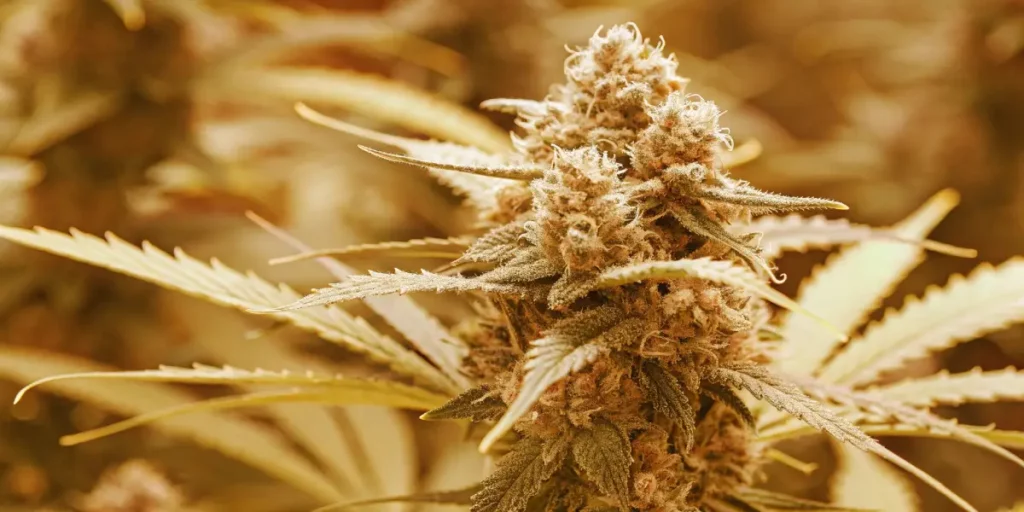
Outdoor Growing Tips
Pink Gorilla, known for its vibrant purple hues and captivating aroma, is a strain that thrives in outdoor environments. When planning to grow this strain outdoors, the first step is to select the right location. Ideally, choose a spot that receives ample sunlight, as cannabis plants require at least 6–8 hours of direct sunlight daily for optimal growth. Ensure that the area is well-ventilated to allow for proper air circulation, which helps in preventing mold and pest infestations.
Next, consider the soil quality. These plants flourish in rich, well-drained soil that is high in organic matter. Incorporate compost or well-rotted manure to enhance soil fertility and structure. This not only provides the necessary nutrients but also improves water retention. Regularly check the pH level of the soil, aiming for a slightly acidic to neutral pH of 6.0 to 7.0, which is essential for nutrient uptake.
Watering is another crucial aspect to consider when growing cannabis outdoors. While it’s important to keep the soil consistently moist, be wary of overwatering. Test the soil’s moisture level by sticking your finger an inch into the ground; if it’s dry, it’s time to water. Ensure proper drainage to prevent waterlogged roots, which can lead to root rot. Consider utilizing mulches like straw or wood chips to retain moisture and suppress weed growth.
Protection against pests and diseases is key to a successful outdoor grow. Regularly inspect your plants for signs of common pests such as aphids, spider mites, and caterpillars. Employ organic pest control methods like neem oil or insecticidal soap to avoid chemical buildup on the plant. Additionally, practicing companion planting with marigolds or basil can help deter harmful insects while encouraging beneficial ones.
How to Germinate & Propagate Pink Gorilla
Pink Gorilla is a cannabis strain that offers a delightful combination of potent effects and pleasing flavors. To successfully grow this strain, knowing how to effectively germinate and propagate it is essential. This process begins with selecting high-quality seeds from a reliable source, ensuring they are healthy and viable. A common method for germination is the paper towel technique. This involves placing seeds between moistened paper towels and storing them in a warm environment. Within a few days, you should see the seeds begin to sprout tiny roots.
Once the seeds have germinated, it’s crucial to transfer them to a growing medium with care, as the young roots are very delicate. A popular option is to use starter plugs or small pots filled with a germination mix made of equal parts peat and perlite. This ensures adequate drainage and aeration. Place the sprouted seed in a shallow hole, covering it lightly with a thin layer of the mix. Ensure that the pots are kept in a warm and humid environment, with temperatures around 70-75°F (21-24°C) to promote healthy growth. Using a heat mat can help maintain a consistent temperature.
During propagation, it’s important to provide consistent moisture without overwatering, which can lead to root rot. Utilizing a spray bottle to mist the surface lightly can aid in maintaining appropriate moisture levels. Moreover, providing ample light is vital, ideally through fluorescent or LED grow lights set at a moderate distance to avoid scorching tender seedlings. As they grow, gradually increase the intensity and duration of light exposure. Once seedlings have developed a strong root system and a few sets of true leaves, they can be transplanted into larger pots or transferred to an outdoor growing area, depending on your cultivation plan.
Vegetative Stage: Nurturing Your Pink Gorilla Plants
In the vegetative stage, Pink Gorilla plants require careful attention and nurturing to ensure robust growth and potentially high yields. This stage is marked by rapid growth, with plants developing strong stems and a lush foliage canopy. Ensuring that the plants have sufficient light during this phase is crucial. They thrive under a light schedule of 18–24 hours of light per day, which helps in maximizing their growth potential and preparing them for the productive flowering stage.
Water management is equally important during the vegetative stage. Overwatering can lead to root rot, whereas under-watering could stunt their growth. It’s essential to strike a balance and allow the soil to dry out slightly between waterings. Using well-draining soil will help mitigate risks associated with overwatering. A consistent watering schedule tailored to the environmental conditions of your grow area, such as humidity and temperature, should be established for optimal plant health.
Nutrient supply is another critical aspect of nurturing cannabis plants during the vegetative stage. Since the plant is developing its structure, applying a higher nitrogen fertilizer will support leaf growth and overall plant health. Consider a balanced mix of nutrients that provides not just nitrogen, but also essential micronutrients like magnesium and calcium that promote strong, vigorous growth. Organic nutrient sources can be particularly beneficial in fostering robust health and stress resistance in your plants.
Monitoring and adjusting the environment is also essential to foster thriving plants. Maintain consistent temperatures between 70–85°F (21–29°C) and relative humidity levels around 40–60%. Fluctuations beyond these ranges can stress the plants, making them more susceptible to diseases and pests. Regularly prune your plants to remove any dead or yellowing leaves, enhance airflow, and allow light to penetrate deeper into the canopy, which can promote even growth.
The vegetative stage is an essential period in the growth of your cannabis plants, setting the foundation for high-quality buds during flowering. By ensuring adequate light, water, nutrients, and environmental controls, you give your plants the best chance to develop into strong, healthy, and productive specimens. Patience and consistent care during this stage will significantly impact the success of your cultivation journey.
Flowering: What to Expect
The Pink Gorilla strain, known for its vibrant hues and potent effects, enters a critical stage during flowering. This period generally begins after the plant has completed its vegetative phase, typically between 8 to 10 weeks from germination. When flowering starts, expect your plants to significantly increase in height and size as they begin to produce buds. The shift in light cycles to 12 hours of light and 12 hours of darkness prompts this development, mimicking the natural progression of seasons. Growers should be prepared for an increase in the plant’s nutrient needs and ensure adequate feeding to support bud growth.
During the flowering phase, this strain will showcase its stunning aesthetics. The buds often develop a pinkish hue, alongside a vibrant mix of deep greens and purples. These visual transformations are not just for show; they are indicators of the plant’s health and vigor. It’s important to regularly inspect the buds for signs of mold or pests, which can be more prevalent due to the denser foliage. Maintaining an ideal humidity level, usually between 40-50%, is crucial to avoid any issues that could compromise bud quality.
A distinct characteristic of this flowering stage is the plant’s robust aroma. As the buds mature, they release a potent fragrance that’s a mix of sweet and earthy tones, often with hints of tropical fruit. This aroma is a delightful sign of the terpenes developing within the plant and can be an indicator of its overall health. Managing the ventilation in the growing space is essential to control these smells and ensure good airflow, which further supports healthy bud development.
The flowering stage also brings specific challenges and rewards. Monitoring the plant’s water intake is crucial, as the buds’ increased mass demands more water but not to the point of saturation. Overwatering can lead to root rot or attract mold, which can severely affect yields and quality. Regular flushing of the plants in the last stages of flowering is recommended to enhance the final taste and smoothness of the smoke, ensuring any excess nutrients are cleared out before harvesting.
Fertilizers & Nutrient Schedule
The Pink Gorilla strain is known for its robust growth and vibrant yield. To ensure it reaches its full potential, a well-planned and precise fertilizer and nutrient schedule is essential. This cannabis variant thrives with a balanced nutrient intake that accommodates its vigorous growth phases. During the vegetative stage, it’s crucial to provide a high nitrogen diet to support robust foliage development, which is necessary for establishing strong structural integrity to support future buds.
As the plant enters its flowering stage, the nutrient demands shift significantly. During this phase, it is advisable to reduce nitrogen levels and increase phosphorus and potassium inputs to encourage the production of large, resinous buds. An excellent way to achieve this is through bloom-specific fertilizers that contain a higher P-K (Phosphorus and Potassium) ratio. These elements play a key role in flower development and must be introduced gradually to avoid nutrient burn or other stress factors that might hinder the plant’s progress.
Moreover, integrating micronutrients such as calcium, magnesium, and trace minerals is vital throughout the growth cycle. Calcium and magnesium support cell wall structure and chlorophyll production, respectively. A deficiency in these can lead to poor absorption of major nutrients and impair growth. It’s beneficial to use a comprehensive cannabis nutrient mix that includes these secondary nutrients to ensure balanced feeding. Consistent monitoring and adjustment of pH levels in the nutrient solution can optimize nutrient uptake, helping the plant to efficiently utilize all the elements.
Adopting a regular feeding schedule tailored to the growth stages of your cannabis strain ensures the plant receives the proper sustenance at the right time. Typically, a feed-water-water-feed routine can prevent over-fertilization, ensuring the substrate is not overloaded with nutrients. Regular flushing of the growing medium is also recommended to prevent salt build-up, which can negatively impact nutrient absorption. By diligently following these feeding guidelines, cultivators can foster a healthy crop, characterized by bountiful yields and potent, flavorful buds.
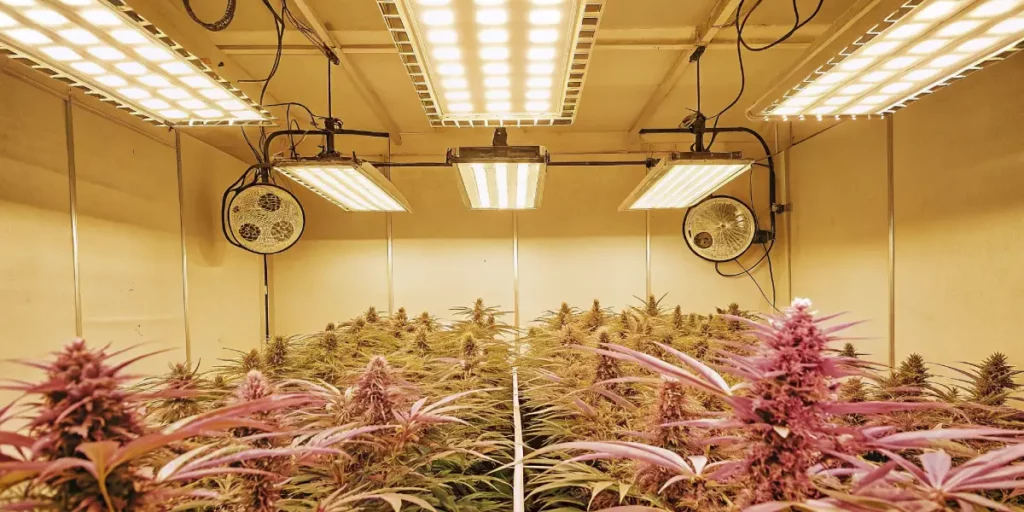
Pest and Disease Prevention for Healthy Cannabis Plants
Growing Pink Gorilla cannabis plants can be an immensely rewarding experience, but maintaining their health requires diligent pest and disease management practices. One of the primary steps in pest and disease prevention is environment control. Ensure that your grow space is well-ventilated, maintaining optimal temperature and humidity levels. This creates an unfavorable environment for many common pests and prevents disease-causing fungi and bacteria from thriving. Regular cleaning of your grow area helps to minimize conditions where pests and pathogens can easily proliferate.
Another crucial aspect of pest and disease prevention is proper plant inspection and monitoring. Regularly inspect your cannabis plants for signs of disease and pests like aphids, spider mites, and powdery mildew. Use a magnifying glass to look under leaves and within the dense foliage to spot early signs of trouble. Early detection is key to controlling outbreaks before they spiral out of control. Establish a routine inspection schedule and maintain detailed observations of plant health to spot trends that might indicate underlying issues.
Besides to manual inspections, consider employing natural and biological control methods to prevent pest and disease outbreaks. Introducing beneficial insects such as ladybugs and predatory mites can keep harmful pest populations in check. Neem oil and other organic sprays can be applied as preventative measures, helping to suppress the early stages of pest infestations without harming the plant. Be sure to use these sprays in accordance with guidelines to avoid excessive application, which could harm the plant tissues.
Lastly, practicing good hygiene in your cannabis cultivation operation is vital. This includes using sterile tools for pruning and training, ensuring contaminated equipment does not transfer pathogens from one plant to another. Plant rotation and proper disposal of plant waste also reduces the risk of recurring infections. By incorporating these preventative strategies, you can safeguard the vitality of your cannabis plants, ensuring a healthy, bountiful yield.
Harvesting & Drying Pink Gorilla the Right Way
Pink Gorilla is a unique strain known for its high potency and vibrant color, characteristic of California’s high-quality cannabis strains. When it comes to harvesting this strain, timing is critical. Growers should keep a close eye on trichome development, which is a reliable indicator of the plant’s readiness for harvest. Ideally, wait for the trichomes to shift from clear to a milky white, with a few turning amber. This state signifies that the maximum THC content and potency have been reached, ensuring an optimal harvest both in terms of quantity and quality.
Once the plants are ready, use sterilized scissors or a sharp blade to cut the branches, taking care to handle the buds gently to avoid any unnecessary damage. It’s advisable to harvest during the early morning hours, as the cooler temperatures help preserve the cannabinoids and terpenes that contribute to the strain’s unique aroma and effects. Ensure that your workspace is clean and free from contaminants to maintain the integrity of the harvest.
After harvesting, the drying process begins, which is equally crucial for the quality and flavor of the buds. Trim away large fan leaves but leave smaller leaves around the bud intact to protect the flower during drying. Hang the branches upside down in a dark, well-ventilated room with a consistent temperature between 60-70°F (15-21°C) and humidity levels around 45-55%. This setup will facilitate a slow drying process, preserving the terpenes and cannabinoid profiles while preventing mold growth.
The drying period usually lasts between 7 to 14 days, depending on environmental conditions. Buds are ready when the smaller stems snap easily rather than bend. After drying, proceed with the curing process, involving placing the buds in airtight jars while regularly opening them for air exchange. This step further enhances the flower’s flavor, aroma, and potency over a few weeks to months, resulting in a superior end product ready for consumption.
Strain Type: Indica, Sativa or Hybrid?
The Pink Gorilla strain is an intriguing addition to the world of cannabis, known for its distinctive characteristics and unique balance. This strain is classified as a hybrid, which means it incorporates qualities of both the Indica and Sativa strains. Hybrids are typically bred to emphasize specific attributes of the parent strains, and in this case, the result is a balanced experience that caters to both body relaxation and cerebral stimulation. Knowing its hybrid nature is crucial for growers and consumers aiming to cultivate or use this strain effectively.
With its hybrid status, this variety leans more toward the Indica side, which is evident in its growth patterns and effects. Indica-leaning hybrids often exhibit a shorter and bushier structure, making them ideal for indoor cultivation. The plant tends to have broad leaves, a trait inherited from its Indica lineage, which helps maximize light absorption. For those looking to cultivate this strain, be prepared for its potential to offer a moderately sedative effect, making it a perfect choice for evening use when relaxation is a priority.
While the Indica influence is prominent, the Sativa elements should not be overlooked. The Sativa component contributes to a subtle yet noticeable cerebral upliftment, complementing the strain’s overall relaxing effects. This balance allows it to offer mild euphoria and increased creativity, which is advantageous for individuals seeking stress relief without the complete couch-lock often associated with pure Indica strains. This makes it an excellent choice for users who desire the best of both worlds, enhancing their mood while ensuring physical relaxation.
To summarize, this hybrid strain skillfully melds Indica and Sativa characteristics. Growers should note its Indica dominance means it thrives in specific growing conditions, particularly indoors, where its growth can be optimized. For consumers, the strain’s hybrid nature provides a balanced experience—melding relaxation and mental clarity—making it suitable for various occasions from creative undertakings to unwinding after a long day. Knowing this hybrid’s distinct Indica-Sativa blend is essential for those looking to cultivate or enjoy it.
Why Grow Pink Gorilla? Key Benefits for Cultivators
Pink Gorilla is rapidly gaining attention among cultivators for its combination of aesthetic appeal and robust growth characteristics. This strain stands out with its vibrant pinkish hues, a trait that not only captivates the eye but also often indicates a healthy plant. For growers, the visual appeal of this exotic strain can be a significant advantage in the competitive cannabis market where unique and eye-catching varieties can command higher prices. Beyond its stunning appearance, it is known for its potent aroma, which can act as a natural marketing tool, attracting customers with its distinctive fragrance profile.
Apart from its aesthetic advantages, this cultivar offers substantial benefits in terms of cultivation ease and yield. Known for its resilience, it can thrive in various growing conditions, making it ideal for both beginners and experienced cultivators. Its resistance to common plant diseases and pests reduces the need for intensive care, allowing cultivators to invest their resources into other aspects of their growing operations. Furthermore, this strain is recognized for producing abundant yields, which can translate into increased profitability for growers who can meet market demand efficiently.
The final product is renowned for its high-quality effects, which include a balanced blend of relaxation and euphoria. This makes it popular among connoisseurs seeking a nuanced experience, thus expanding its market appeal. Additionally, its versatility allows it to be cultivated indoors or outdoors, offering flexibility to growers depending on their available space and resources. This adaptability further increases its value as a reliable cultivar with potential high returns on investment. Cultivators choosing this strain benefit from its combination of beauty, resilience, and profitability, marking it as a cultivar worth considering for any cannabis growing operation.
Potential Challenges When Growing Pink Gorilla
Growing Pink Gorilla cannabis can be an exciting venture due to its unique profile, but it presents several challenges that growers should be prepared to manage. One of the primary challenges is ensuring the right environmental conditions. This strain prefers a controlled environment with specific temperature and humidity levels. Consistent temperature fluctuations or excessive humidity can lead to plant stress, which might impact growth and bud quality. Growers need to invest in proper equipment such as HVAC systems, dehumidifiers, and humidifiers to maintain ideal growing conditions.
Another challenge faced by cultivators is pest and disease management. Like many cannabis strains, this one is susceptible to common pests like spider mites, aphids, and fungus gnats. It is also prone to fungal infections such as powdery mildew and botrytis. To combat these issues, growers should implement regular inspections and adopt integrated pest management strategies, including the use of organic pest control solutions and ensuring good air circulation around the plants.
Moreover, achieving optimal nutrient balance can be a delicate task when cultivating this variety. It may respond negatively to nutrient imbalances, which can manifest in nutrient burn or deficiencies, affecting plant health and yield. Growers must tailor their feeding schedules and make necessary adjustments based on the plant’s response. Use of high-quality soil with balanced pH levels and appropriate nutrient concentrations can mitigate these risks. Regular testing of soil and water pH levels, along with monitoring nutrient uptake, is essential for maintaining plant health.
The flowering stage introduces another layer of complexity as it demands close attention to ensure bud health and potency. This strain typically has a flowering time of about 8–10 weeks and benefits from careful pruning and training techniques to maximize light penetration and promote even growth. Growers should be vigilant for signs of stress during this period, such as leaf discoloration or stunted growth, which might indicate underlying issues that need immediate intervention.
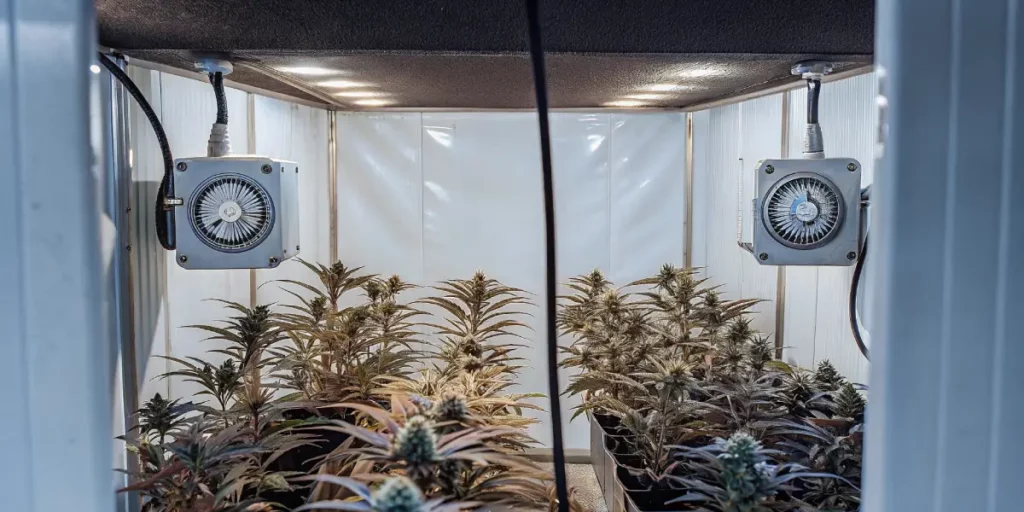
Is Pink Gorilla Worth Buying? Here’s What You Need to Know
Pink Gorilla is one of the more intriguing cannabis strains available on the market today, known for its unique blend of flavors, potency, and vibrant aesthetic appeal. Its name is derived from its eye-catching pinkish-purple buds that can truly stand out in any grower’s collection. Derived from a powerful lineage, this strain boasts a compelling mix of taste and potency that can make it a notable choice for both recreational and medicinal users. However, deciding whether this strain is worth buying involves knowing several key factors, including its growth requirements and potential yield.
For growers, this hybrid offers a challenging but rewarding cultivating experience. It can thrive both indoors and outdoors, although it prefers warmer climates when grown outside. When considering its cultivation needs, it’s essential to note that this variety requires a diligent approach to temperature and humidity control to maximize its flowering potential. Its flowering time is relatively average at around 8–10 weeks, delivering a decent yield that can satisfy both small-scale hobbyists and more serious growers. It’s an attractive option for those looking to experiment with a colorful and exotic addition to their grow space.
Regarding its effects and benefits, this hybrid stands out with its balanced quality, often resulting in a potent yet manageable high. Users report a euphoric yet calming effect, making it suitable for both daytime and evening use. Its flavor profile, dominated by sweet, fruity notes with hints of earthiness, adds an extra layer of enjoyment to the experience. For those seeking relief from stress or anxiety, or for those simply looking for a relaxed state of mind, this strain may be an ideal match. Ultimately, for those with a keen interest in unique genetics and the dedication to cultivate it properly, it can absolutely be worth the investment.
FAQs
What is the best environment to grow Pink Gorilla strain indoors?
Pink Gorilla thrives in controlled indoor environments where temperature, humidity, and lighting remain consistent. Maintain temperatures between 70–80°F (21–27°C) during the day and slightly cooler at night. During vegetation, aim for 60–70% humidity, gradually reducing to 40–50% as flowering progresses. Full-spectrum LED grow lights are ideal, positioned 18–24 inches above the canopy to ensure even light distribution. A pH range of 6.0–6.5 in soil or coco medium allows optimal nutrient absorption, while oscillating fans and carbon filters help manage airflow and odor.
How long does Pink Gorilla take to flower, and when should it be harvested?
The flowering period for Pink Gorilla strain typically ranges from 8 to 10 weeks, depending on phenotype and growing conditions. As harvest approaches, monitor trichome coloration closely — buds are at peak potency when trichomes turn milky white with 10–20% amber hues. Growers cultivating outdoors should plan to harvest around early to mid-October. Reducing nutrients two weeks before harvest (a “flush”) improves flavor purity. Once harvested, dry the buds at 60–70°F and 45–55% humidity for 7–14 days to preserve terpenes and potency.
What nutrient schedule works best for Pink Gorilla plants?
Pink Gorilla responds best to a stage-specific feeding schedule. During the vegetative phase, use nutrients high in nitrogen (N) to promote robust foliage and root growth. As the plant transitions to flowering, shift toward a bloom formula rich in phosphorus (P) and potassium (K) to encourage bud density and trichome production. Supplement with calcium and magnesium throughout the cycle to prevent deficiencies. Maintain nutrient solution pH between 6.0–6.8 for optimal uptake, and flush the substrate every 2–3 weeks to prevent salt buildup that could inhibit growth.
What are the main terpenes and flavor notes in Pink Gorilla strain?
The Pink Gorilla strain is rich in myrcene, caryophyllene, and limonene, which together produce a sweet, fruity aroma with earthy and floral undertones. Myrcene contributes to its relaxing, sedative effects, caryophyllene offers peppery spice with anti-inflammatory potential, and limonene brings uplifting citrus accents that enhance mood. Proper curing at 60°F (15°C) and 50% humidity over several weeks helps these terpenes mature fully, resulting in a smooth, flavorful smoke with hints of tropical fruit and a subtly creamy finish.
How can I prevent mold and pests when growing Pink Gorilla strain?
Due to its dense, resinous buds, Pink Gorilla can be vulnerable to botrytis (bud rot) and powdery mildew if humidity isn’t well controlled. Keep humidity under 50% during flowering, ensure consistent airflow, and prune excess foliage to enhance ventilation. Inspect leaves weekly for spider mites and aphids, using organic neem oil or insecticidal soap as preventive measures. Sterilize tools between uses and avoid overwatering to prevent fungal issues. Maintaining a clean, well-ventilated grow space is the most effective long-term defense against pests and pathogens.

